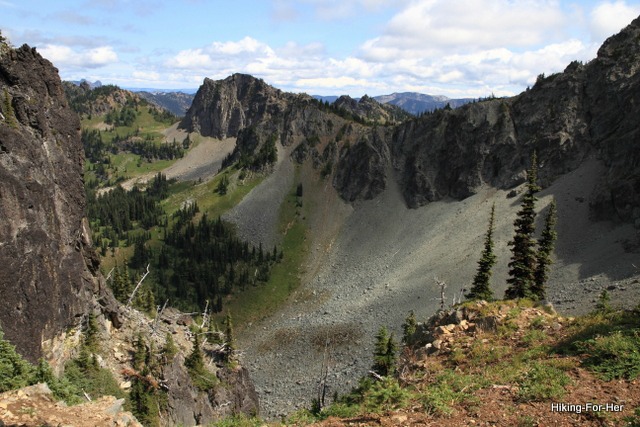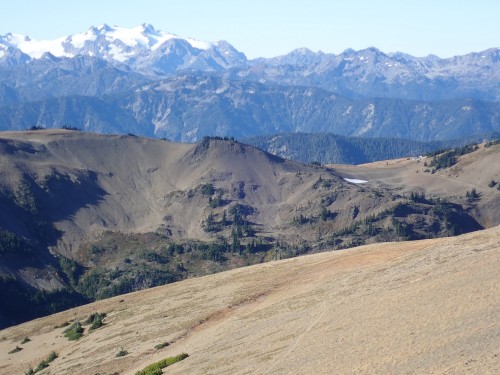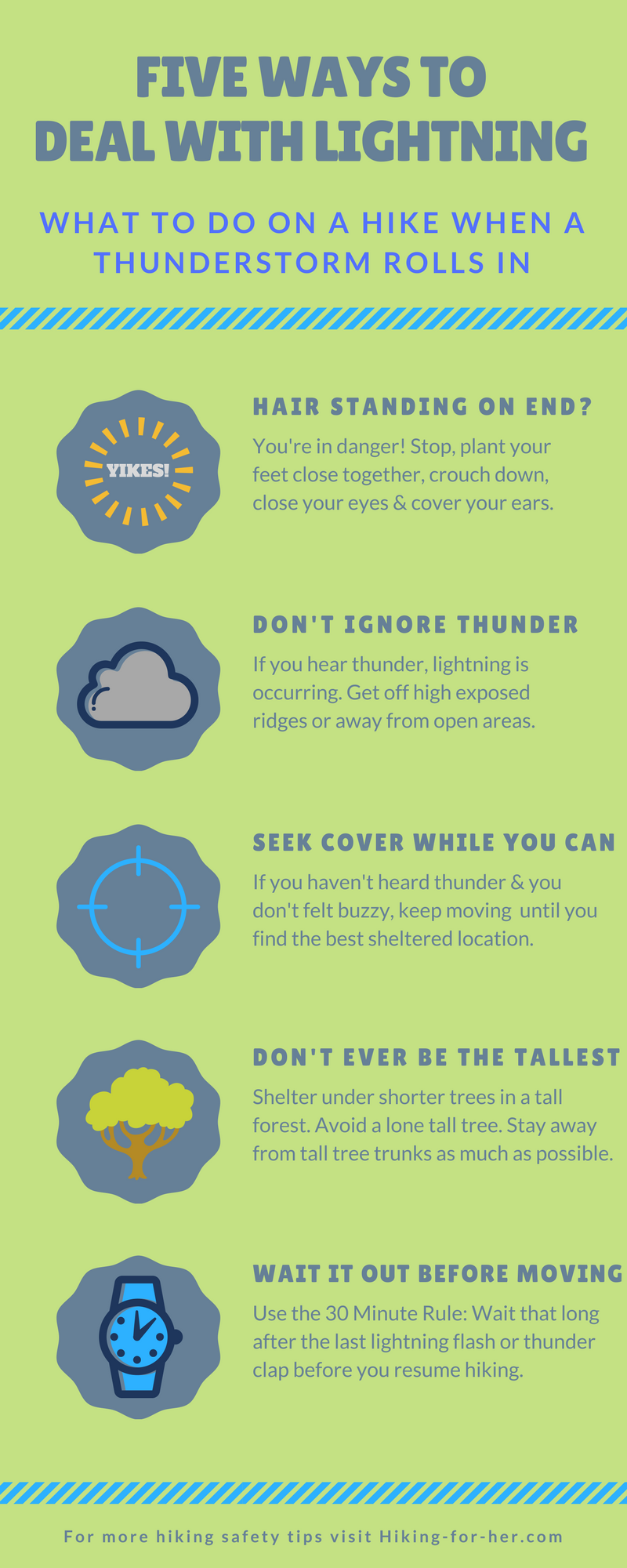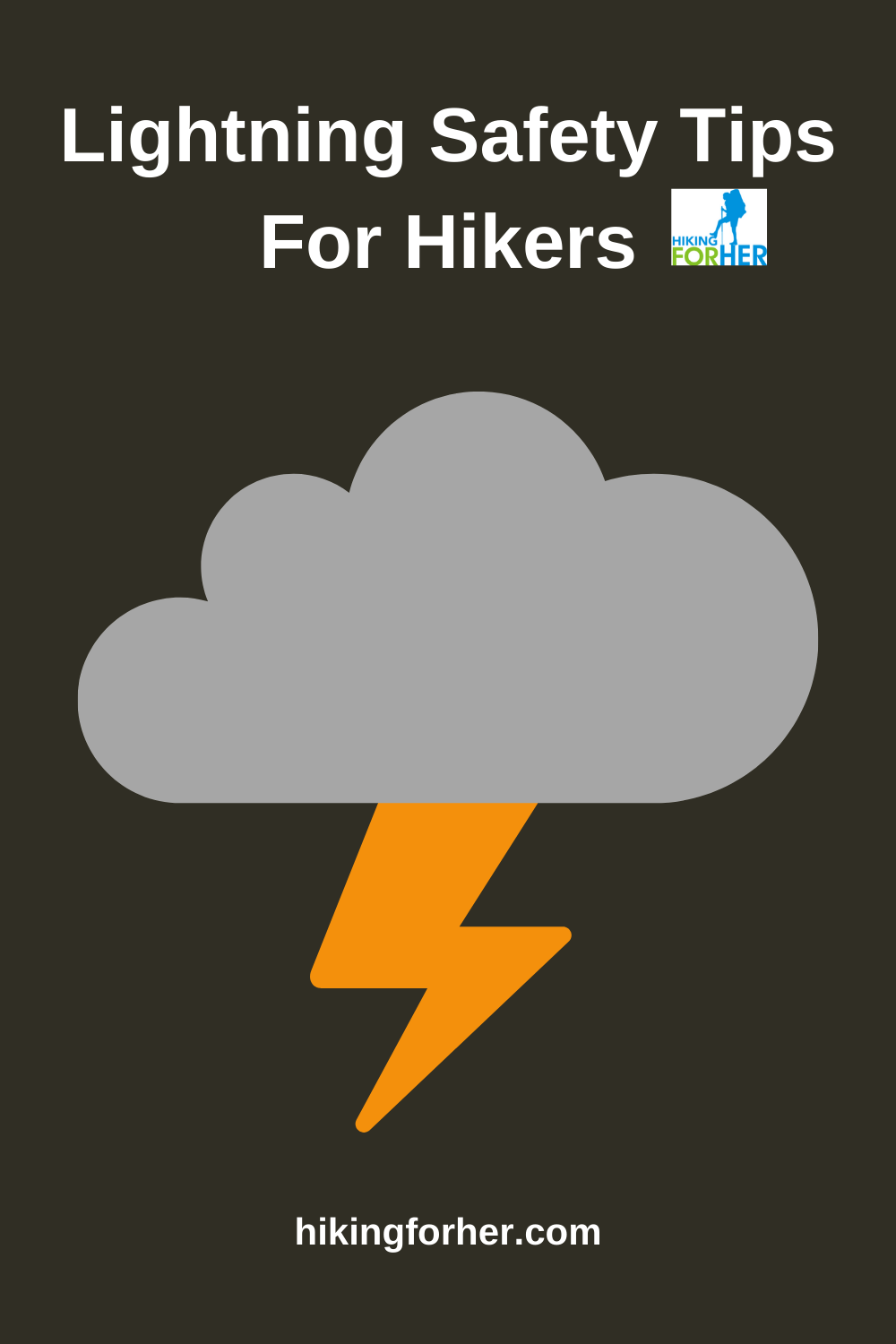
Lightning Safety For Hikers:
Best Tips For Survival On A Hike
By Diane Spicer
Lightning safety for hikers involves knowledge, planning, awareness, behavioral adaptations, and more knowledge.
I'm so glad you're reading this page!
While it's not likely that you'll face a dangerous lightning situation (unless you like to hike in high alpine summer conditions), it's important to know what to do if it happens.
U.S. lightning statistics to be aware of as a hiker
- About 50 people per year are killed by lightning in the United States (probably a low estimate because many cases are never reported).
- Your odds of being struck in any given year are about 1 in a million.
- The states with highest risk of lightning strikes include those along the Atlantic coast, Florida, and the southeastern coast of the Gulf of Mexico.
- Hikers who frequent high alpine terrain in the western states during the summer are also at higher risk due to afternoon thunderstorms that build up as the day heats up.
- And no surprise that if you hike in tropical and sub-tropical areas outside of the United States, your odds of a lightning strike are much higher.
If you've ever been caught out in a thunderstorm, you know how hair raising the experience can be - sometimes literally.
- Hundreds of people in the U.S. are injured every year.
- Some of the survivors suffer chronic neurological damage.
Now it's time to find out why hair raising is one of the worst signs you can face!
Let's roll through all of the ways you can keep yourself as safe as possible while hiking in a lightning prone area.
Lightning safety for hikers: know before you go
I know that not every hiker is as fascinated with weather as I am, so I'll provide two quick resources on lightning safety for you here:
- a few links to lightning resources which you can visit when you're ready for details,
- a short, sweet version of the lightning safety information you need to hit the trail.
Resources for lightning safety for hikers
Free lightning safety resources for hikers will give you the background of how lightning can reach you, affect your body, and what you can do to minimize your exposure to danger.
What better website to visit than the U.S. government's NOAA, National
Oceanic and Atmospheric Administration?
- Lightning FAQs from NOAA
That takes care of the knowledge portion of our lightning safety discussion.
Now it's time for action.
Lightning safety tips you need before you hit the trail
If you're planning a hike for the next day, there is a lot you can do to avoid being caught off guard by the weather.
Read the weather
I mean that literally!
Read the weather forecast for the area you are planning to spend time in.
It may be bright and sunny at your front door, but who knows what's happening, or predicted to happen, in the mountains?
The weather forecasters, that's who.
A "surprise" storm just doesn't exist.
So after you read what they have to say, read the sky.

This lenticular cloud has a message for you, and if you don't know what it is, this page will get you started thinking about safe hiking weather habits.
Lightning safety for hikers:
tips you need on the trail
Here is the short version of "what to do when you hear thunder and see flashes of lighting on a hike".
Also known as the Oh, sh*t strategy.
Pay attention to environmental cues
It's easy to get wrapped up in the beauty and pleasure of a great hiking trail.
But because you did your homework and read the weather forecast, you realize how important it is to pay attention to the not-so-subtle hints that Mother Nature throws your way prior to a storm.
- Warm, humid days are her favorites for thunderstorms.
This is especially true if you hike in mountainous exposed areas where summer thunderstorms are common in the summer months.
- Set, and stick to, a turn around time that gets you off the mountain early in the day.
- Turn around early if a storm is approaching.
Don't ignore these environmental cues of an impending storm:
- dark, heavy clouds
- sudden shift in wind direction, or wind gusts
- thunder, because it's impossible to have lightning without thunder
If you're already seeing lightning, or there are loud thunder booms telling you the storm is one to ten miles away and coming your way, it's time to take the next step in lightning safety for hikers.
Survey your surroundings with an eye to shelter

Look around.
It's time to find a safe, or safer, place to ride out the storm.
Note any of the following hazards:
- you're on a peak or ridge
- the ground you're on is significantly higher than surrounding terrain
- you're inside a tent with metal poles
- tall trees are surrounding you
- you're beneath a single tall tree
- you're on wide open ground at a lower elevation
- your feet are in water (bog, stream bed) or on wet snow
- you're near surface water (pond, lake, stream)
- you're on or near metal cables or wet ropes
(like a suspension bridge or fixed trail aids) - small overhangs or a cliff that can allow a charge to travel across the gap are above you
- you're in a group of hikers
At this point, lightning safety for hikers involves assessing your location and your chances of minimizing damage from a lightning strike.
Check for conduction pathways
Toss your trekking poles, crampons, ice axe and other metal hiking gear away from your body.
If your backpack has a metal external frame, move away from it.
Remove metal on your body (jewellery or a belt buckle, for instance) to avoid the risk of burns. This metal won't attract lightning, so if time is of the essence, leave it on.
If you're in a forest, stay away from large tree trunks as much as possible.
If your hair is standing on end, or you feel a buzzy sensation pass across your skin, you're in danger of being struck (your body is a "positive streamer" that can connect with charged particles in the storm clouds).
- Be sure to read the information below to make yourself less of a target in this situation.
Don't make yourself a lightning rod
 Get off high exposed places when the weather predicts thunderstorms or you see ominous clouds forming
Get off high exposed places when the weather predicts thunderstorms or you see ominous clouds formingStanding up tall and proud is not what you want to be doing as the lightning moves closer.
If you are directly beneath the storm clouds and lightning is crashing around you, stop moving and assume the lightning position.
- Crouch low.
- Duck your head.
- Wrap arms around legs or cover your ears with your hands to avoid hands touching the ground.
- Keep feet together.
- Close your eyes.
- You can sit on a foam pad or pile of clothing, making it more likely that you will stay in the tucked position for a long period of time.
- No worries if the ground beneath you is wet. It won't conduct electricity more than dry ground, and in fact might help disperse ground current.
Important distinction
This crouched position does not enhance your safety, but it does reduce the chances of being seriously injured if struck because the electrical charge will disperse more quickly.
If you have the luxury of time before the storm hits, head for lower ground.
- A depression or dry ravine would be even better, unless flash flooding is common in the area.
If you've got hiking companions, be sure to spread out. This maximizes the chances of someone being unhurt and able to help any victims.
As tempting as it may be to resume hiking once the thunder stops, wait at least 30 minutes for the storm to clear out. Eat a snack, drink water, relax until you've left half an hour go by.
What to do when lightning strikes
We might as well go big or go home in our discussion of lightning safety for hikers.
If your trail buddy is hit by lightning, you need to do these things quickly:
- Assess for cardiac arrest: no breathing or pulse. Oxygen is not reaching vital organs.
- Administer CPR immediately: rescue breathing if no breathing but a pulse is present, or chest compressions in the absence of a pulse.
- The person will not pass an electrical charge to you, because the ground has dissipated it.
You also need to watch for these signs and symptoms if cardiac arrest did not occur:
- Concussion type issues such as headache, vomiting, dizziness and confusion
- Tingling sensations
- Sore muscles
- Broken leg or foot bones
- Trouble with balance
- Superficial burns
- Hearing and/or eyesight loss
Lightning safety for hikers tip: You don't want to get a hiker back on the trail until you've assessed them for these potential complications. You will endanger them, and yourself.
Longer term and delayed problems will need to be screened for once the lightning victim has returned home.
For a thorough discussion of the medical issues related to lightning injuries, read this article.
Lightning safety for hikers recap
Any questions about lightning safety for hikers?
Please let me know if you need more information about this important safety issue for hikers.
I've had my share of close calls in the mountains during storms, which have motivated me to know what to do, and how to avoid trouble, when I see lightning moving in.
Hopefully you will never have to ride out a thunderstorm. But if you do, now you know exactly how to do it.
You want to be around to enjoy the rainbow, right?
For more safety tips on the trail, visit my safe hiking tips page.
Home page > Best Hiking Tips >
Lightning Safety For Hikers
|
I get emails all the time about what I wear, eat, carry and love to use on the trail. That's
why I provide affiliate links to you: the best gear that I use myself and have seen used by other hikers is instantly
available for your consideration, and the gear company sends a few
pennies per dollar to this reader-supported hiking website. There is no added cost to you! Everyone ends up a winner: Great gear for you, strong gear companies, and more free hiking tips for everyone. Thanks very much for your support. It's warmly and sincerely appreciated. It also helps send these hiking tips to all your virtual trail buddies around the globe. |
 |



